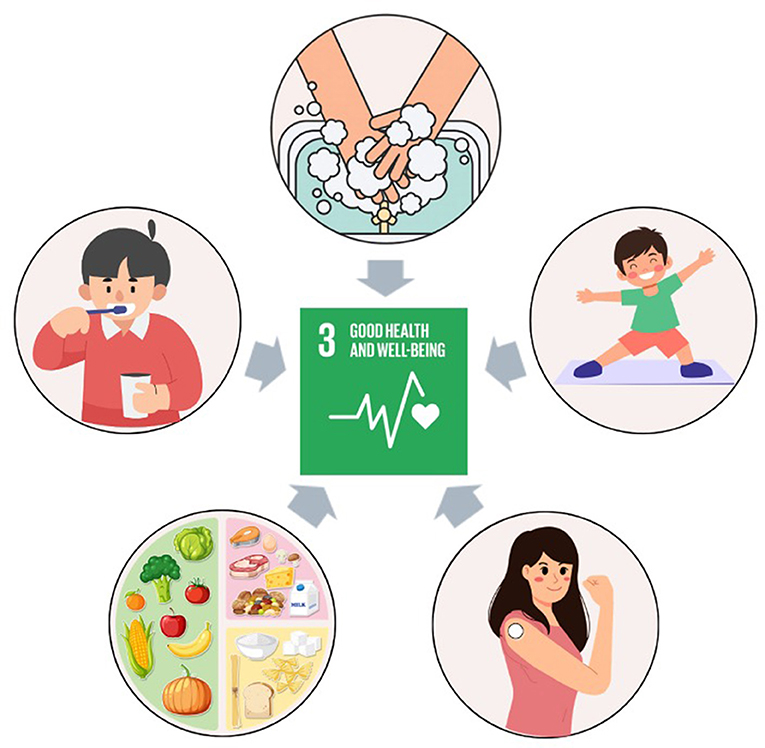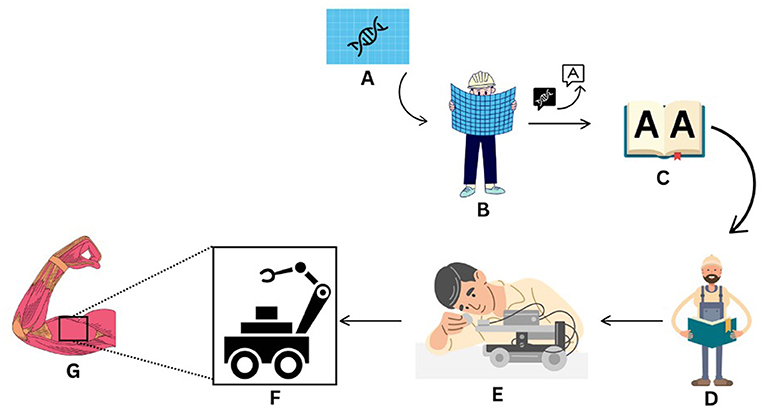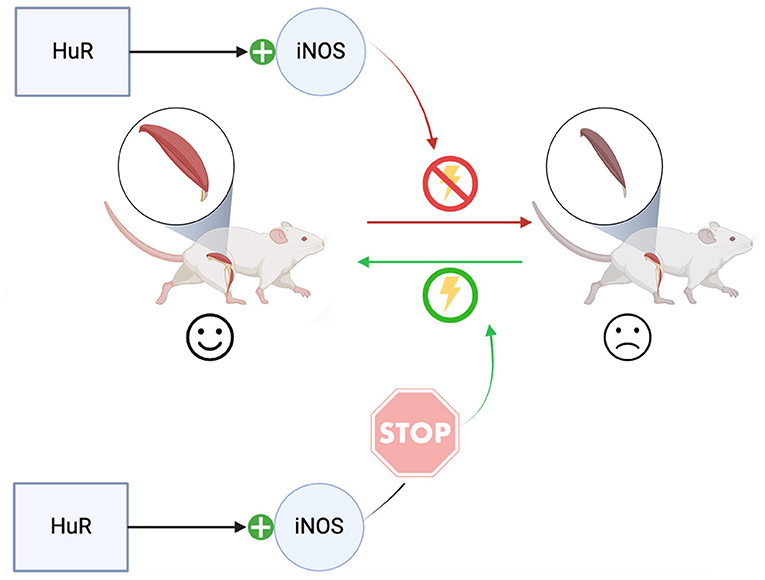Abstract
The third Sustainable Development Goal (SDG 3—Good Health and Wellbeing) is one of the goals the United Nations created to make sure people live healthy and happy lives. Biology, the study of living organisms, can help us achieve SDG 3. One important example of how studying biology can keep people healthy is how science rapidly developed the vaccines that put an end to the coronavirus pandemic, a global health crisis. This was made possible by the efforts of scientists who studied how proteins are made by cells. We, along with other scientists, are studying the steps involved in making proteins to find ways to prevent and treat muscle diseases. This article highlights why health is important, some of the things everyone can do to stay healthy, and how studying diseases—and solving them by understanding biology—can help many people around the world live healthier, longer lives.
Watch an interview with the authors of this article to learn even more! (Video 1).
Why Good Health Matters
The United Nations (UN) is an international group of countries that cooperate to promote peace and development. To achieve this, the UN made a list of Sustainable Development Goals (SDGs) that aim to create a sustainable world for everyone. Good health is important for people to live happy lives, and that is why the third Sustainable Development Goal (SDG 3) is about “Good Health and Wellbeing: Ensure healthy lives and promote wellbeing for all at all ages”. SDG 3 aims first to ensure everyone can go to a hospital when they need to. This is because, unfortunately, not everyone has access to hospitals or doctors, which makes it difficult for those people to get the help they need. Second, SDG 3 focuses on keeping child births safe, stopping disease spread, and helping people to be mentally and physically healthy. Scientists have an important role in reaching this goal, by understanding and stopping all kinds of diseases. However, there are many things all of us can do to help achieve SDG3, so that we can enjoy longer and healthier lives (Figure 1).

- Figure 1 - Things you can do to stay healthy.
- There are many things people of all ages can do to have good health and wellbeing throughout their lives. Examples include washing your hands regularly, exercising, getting vaccinated, eating healthy foods, and practicing good hygiene.
SDG 3 can be linked to many other SDGs, and can influence or be influenced by them. For example, having enough healthy food (which is the aim of SDG 2—Zero Hunger) and clean water (which is the aim of SDG 6—Clean Water and Sanitation) are needed for health. Without good food and clean water, people can get sick easier. Good health also enables other goals, like SDG 4—Quality Education, which aims for everyone to get a good education and a chance to keep learning. Healthy children can go to school and learn better. Education also helps people learn how to live healthy lives and prevent diseases. So as you see, these goals need to be achieved together to make everyone’s lives better around the world.
How Does Science Help us to Stay Healthy?
Science plays a big role in helping everyone stay healthy. Biology, which is the science that studies all living things, asks important questions about how our bodies work and why we get sick. By researching and finding those answers, biologists can understand diseases better and help doctors figure out how to stop them. Biologists can study humans, animals, plants, and all other living things, and cell biologists focus specifically on cells—the smallest part of all living creatures.
Cell biology worked to make our lives better during the coronavirus pandemic, a global health crisis in which people all over the world started getting sick from a mysterious virus. Scientists and doctors all over the world quickly begin studying the problem. And, after realizing it was caused by a new coronavirus, they worked together to answer important questions like, “What does the virus look like?” and “What parts of the virus are responsible for making us sick?”. Using powerful microscopes, they discovered that the virus had spike-like proteins on its surface. These proteins were found to allow the virus to enter our cells and cause disease. This discovery helped them develop the vaccine that protected people everywhere from the virus and ended the pandemic. This was made possible by building on the knowledge gained from the hard work of all the scientists who came before! One important piece of knowledge we already had was how proteins are made in cells and what their functions are—which is what we study at KAUST, in the Laboratory of Integrative RNA Biology in Health and Diseases.
How are Proteins Made and What Do They Do?
To understand how proteins are made, imagine a factory (Figure 2). The blueprint for making proteins is stored in our DNA, and this blueprint needs to get to the “builders”, or ribosomes, which are small structures inside our cells that build the proteins. However, the builders cannot understand the blueprints coded in our DNA. Special proteins, the “designers”, read the DNA and create a message called messenger RNA (mRNA), which is in a format our ribosomes can understand. Proteins then do all sorts of functions in the body like telling a cell what to do, fighting off invading germs, and moving the muscles.

- Figure 2 - Protein production can be compared to a factory.
- (A) The instructions for making proteins are contained within DNA, the blueprint. (B) The blueprint must be translated into a language that the workers in the factory can understand, and that is the job of a certain type of protein. (C) The message, called mRNA, is delivered to the builders, which are the ribosomes that create the proteins (D, E). (F, G) Proteins are needed in all organs of our bodies, including the muscles that allow us to breathe, eat, and move.
Muscles are organs that control very important actions like breathing, eating, talking, and moving around. Proteins are the main unit within the muscles—without them, these important activities cannot happen. Some diseases, like cancer, result in a loss of muscle proteins and cause muscles to slowly decay, which is called cachexia. Studying cell biology and proteins helps scientists understand cachexia and other muscle diseases, so they can figure out how to treat them. But science is made of never-ending questions and we are always learning something new… even about processes we thought we fully understood. While learning how proteins were made in the cell, biologists discovered another set of players involved protein production.
RNA Binding Proteins: The Superheroes of Protein Building
The process of building proteins starts with the designers writing the instructions in the builders’ language. Then the message is delivered to the builders who read it and follow the instructions to make proteins. However, scientists discovered that the mRNA message is vulnerable during its journey from the designer’s office to the builders’ station. It is often targeted by villain proteins that destroy this message, and that is why mRNA is considered an unstable molecule. Without mRNA, the builders cannot make the many proteins a cell needs to keep the body functioning and healthy. Muscles, for example, start as early muscle cells that grow into mature cells that make up strong, healthy muscles. To do so, the early muscle cells need a set of proteins that help them mature [1]. If the mRNA for these proteins gets broken down too fast, a person would not have enough protein to make the strong muscles they need to stand, move, or breathe. How can such unstable mRNA molecules make important proteins?
The answer to that question was discovered when biologists identified superheroes that ward off the villians and protect the mRNA messages during their journey. These superheroes are called RNA binding proteins (RBPs). Biologists, including our team at KAUST, want to understand more about RBPs and how they affect the muscles. Through experiments like isolating RBPs while they are bound to mRNA or preventing them from interacting with mRNA, we discovered that RBPs control what happens to an mRNA molecule—by protecting it from breaking down, moving it from one place to another, or even controlling how it is shaped [2]. By doing so, RBPs allow many normal functions to happen, like muscle maturation [3]. However—plot twist—we recently made the surprising discovery that some RBPs can turn into villians!
We discovered that a specific RBP called HuR is linked to cachexia (Figure 3). By studying this in mice, we observed that mice were protected from cachexia when the HuR RBP was absent [4]. This was confusing, because for so long we thought RBPs were protectors, and not villains! As we studied HuR, we discovered that it protected the mRNA that makes a protein called inducible nitric oxide synthase (iNOS). This protein makes a molecule called nitric oxide, which is produced in muscles in response to disease signals and can disrupt energy production, leading to muscle loss [5]. It is like HuR was a villain without knowing it, because it protected the mRNA of a protein (iNOS) that acts like a villain. By doing so, it enabled iNOS to wreak havoc in the muscles!

- Figure 3 - How RBPs are linked to muscle diseases.
- The RNA-binding protein HuR is important for stabilizing the mRNA of iNOS (represented by the green plus sign), a protein that contributes to cachexia. We tried to stop iNOS with a drug in mice (represented by the STOP sign) and found that stopping iNOS protected mice from developing cachexia—and even helped reduce cachexia in mice that were already sick with it.
We asked a simple question: if iNOS is important for cachexia, can we stop iNOS and help the muscles? This question led us to discover that, by using a drug that stops iNOS, we could protect mice from cachexia, and even help the mice that already had it to recover [6]. These findings will help scientists and doctors develop treatments that will help people who suffer from cachexia lead healthier lives. If it was not for studying RBPs, we would not have understood the role of iNOS and the benefit of stopping it. That is the role cell biologists play in identifying potential treatment targets, through understanding normal systems like protein building.
Biology for Health And Wellbeing
In summary, our research showed that proteins like HuR and iNOS play important roles in causing muscle breakdown. In fact, when we stopped iNOS, we prevented a muscle-breakdown disease called cachexia from developing in mice. In the future, our findings could lead to drugs that can stop cachexia in human patients. Our lab studies what keeps muscles healthy and what makes them sick. Studying and treating diseases is one of the many ways that biologists help achieve the UN’s SDG 3—Good Health and Wellbeing. This goal aims to ensure people have access to medical help, and that everyone stays healthy.
If you like superheroes and understanding how they work against villains, then studying living cells and figuring out how they work might be for you. But it is not just the joy of seeing superheroes at work—in biology, we also help people to become healthier and happier!
Glossary
Protein: ↑ A tiny building block in living things that supports them and helps them grow.
DNA: ↑ The special code inside every living thing that carries instructions for how the body grows, works, and looks. Your DNA is like a blueprint for building you!
Messenger RNA (mRNA): ↑ A molecule that carries genetic instructions from DNA to the parts of the cell that make proteins.
Cachexia: ↑ A muscle condition that happens to people with long-term diseases like cancer, and that leads to the destruction of proteins inside the muscle, preventing them from healing.
RNA Binding Protein: ↑ A type of protein that binds mRNA and helps move it, protect it from breakdown, and promote its translation into proteins.
Muscle Maturation: ↑ The process by which early muscle cells fuse, organize themselves, and grow in size to form big, healthy muscles.
Inducible Nitric Oxide Synthase: ↑ A protein that produces nitric oxide. It is made in response to signals, especially in muscles during cachexia.
Nitric Oxide: ↑ A gas made of nitrogen and oxygen. It has different tasks depending on time and location. For example, in cachexia it leads to energy imbalance.
Conflict of Interest
The authors declare that the research was conducted in the absence of any commercial or financial relationships that could be construed as a potential conflict of interest.
Acknowledgments
We would like to thank Ruben Costa and Nicki Talbot at KAUST for their invaluable support during the initial writing stage and review process, without which this collection would not have been possible. We also extend our gratitude to the KAUST Office of Sustainability and the UNDP Saudi Arabia Country Office for their dedication to raising awareness of the UN SDGs in our journey toward a more sustainable world. The figures in this manuscript were generated with Biorender.com and Canva.com.
AI Tool Statement
Any alternative text (alt text) provided alongside figures in this article has been generated by Frontiers with the support of artificial intelligence and reasonable efforts have been made to ensure accuracy, including review by the authors wherever possible. If you identify any issues, please contact us.
References
[1] ↑ Chal, J., and Pourquié, O. 2017. Making muscle: skeletal myogenesis in vivo and in vitro. Development 144:2104–22. doi: 10.1242/dev.151035
[2] ↑ von Roretz, C., Marco, S. D., Mazroui, R., and Gallouzi, I.-E. 2011. Turnover of AU-rich-containing mRNAs during stress: a matter of survival. WIREs RNA 2:336–47. doi: 10.1002/wrna.55
[3] ↑ van der Giessen, K., Di-Marco, S., Clair, E., and Gallouzi, I. E. 2003. RNAi-mediated HuR depletion leads to the inhibition of muscle cell differentiation. J. Biol. Chem. 278:47119–28. doi: 10.1074/jbc.M308889200
[4] ↑ Janice Sánchez, B., Tremblay, A-. M. K., Leduc-Gaudet, J-. P., Hall, D. T., Kovacs, E., Ma, J. F., et al. 2019. Depletion of HuR in murine skeletal muscle enhances exercise endurance and prevents cancer-induced muscle atrophy. Nat. Commun. 10:4171. doi: 10.1038/s41467-019-12186-6
[5] ↑ Di Marco, S., Mazroui, R., Dallaire, P., Chittur, S., Tenenbaum, S. A., Radzioch, D., et al. 2005. NF-κB-Mediated MyoD decay during muscle wasting requires nitric oxide synthase mRNA stabilization, HuR protein, and nitric oxide release. Mol. Cell. Biol. 25:6533–45. doi: 10.1128/MCB.25.15.6533-6545.2005
[6] ↑ Sadek, J., Hall, D. T., Colalillo, B., Omer, A., Tremblay, A. K., Sanguin-Gendreau, V., et al. 2021. Pharmacological or genetic inhibition of iNOS prevents cachexia-mediated muscle wasting and its associated metabolism defects. EMBO Mol. Med. 13:e13591. doi: 10.15252/emmm.202013591
